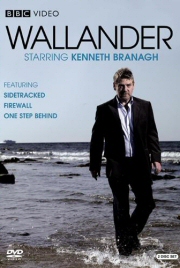- Drama
- 2008
- Buy the DVD
Reviewed by Ross Ruediger
()
here are two bold strokes with which “Wallander,” a BBC produced crime series, is painted that set it apart from most other TV fare. The first is its intoxicating, borderline hallucinatory photography, which will grab your attention in the opening frames. A girl pushes her way through a golden field of crops carrying a plastic container of liquid. A car, driven by Kurt Wallander (Kenneth Branagh), speeds down the highway toward a farm. He pulls up and the farmer points to the field. “She’s out there.” He hands Wallander a pair of binoculars. “You see her?” Wallander makes his way through the dense field of yellow. The closer he gets, the more frightened the girl becomes. When he’s but a few feet from her, she opens the container and douses herself with gasoline, sets herself on fire, and explodes in a ball of flame. Wallander’s jaw hits the ground. He cannot believe what he’s just witnessed. Later on, when one of his fellow detectives suggests moving on from the suicide, since there’s no real crime involved, Wallander himself explodes, “A 15-year-old girl sets herself on fire and you don’t think it’s a crime!?” It’s something of an uncharacteristic moment for the normally subdued man, who keeps his emotions bottled up inside. Indeed, the only time his feathers ever seem to ruffle is in matters of pursuing justice.
But back to the photography. The entire opening sequence is bold and filmic, as is much of “Wallander.” The series is shot with the Red One, a digital camera with a sensor that, according to Wikipedia, “has about the same active area as a 35mm film frame masked to the 16:9 aspect ratio, allowing the same depth of field to be produced in conjunction with lenses designed for 35mm film.” In other words, this camera manages to make some damn pretty pictures – stuff you wouldn’t expect to see in a BBC produced show. It’s possible that at times the cinematographers even go a little overboard, but they probably had so much fun experimenting with the camera they should be forgiven such indulgences.
The second item of note is the fact that the show is in English. This wouldn’t be such a big deal if not for the fact that the show is set and filmed in Sweden, all of the characters are Swedish, and most noticeably, anytime any written language is shown, such as newspapers or e-mails, the words are in Swedish. But everyone in the series speaks English, and with a British accent no less. This took some time to get used to, but after a while the viewer is forced to submit to the gimmick, and it manages to somehow seem a mildly brilliant construct on the part of the producers. I kept thinking back to the early scene in “The Hunt for Red October” where all the Russians were speaking Russian until the picture subtly shifts and they all speak English; “Wallander” simply doesn’t have the shift. It’s a brave leap of faith that could easily have been avoided by tweaking the tales a bit, and simply setting them in England. Clearly the people involved in the making of this series have enormous respect for the source material, a series of hugely popular books by Henning Mankell, the “master of Swedish crime fiction” who, it turns out, is married to Ingmar Bergman’s daughter.
“Wallander” is less a TV series than it is a trilogy of films, and all three 90-minute installments beg repeat viewings. “Sidetracked” involves a killer who scalps his victims. “Firewall” deals with computers. “One Step Behind” is the most personal of the three for Wallander, as it involves the death of his friend and colleague. To say much more about the finer details of these stories would quite literally be criminal, because they’re so labyrinthine in their plotting, that a big part of the viewing pleasure is in experiencing and being surprised by their complexity. They are dark, sinister stories that offer up only begrudgingly “happy” endings. They are not fast-paced by any means, and require a great deal of attention to get the most out of them.
Branagh’s take on the title character must be some of the best, most intense work of his entire career. Wallander is a good man, but very flawed. He has little time for family, which is why he’s divorced, and in one episode admits that he was a rotten father, although you wouldn’t know it based on the way his daughter (Jeany Spark) looks at him. He grunts most of the time, never smiles, and has a face that’s stared down at dozens of corpses. It’s as if the guy carries the baggage of every case he’s ever had around with him every day of his life. There’s a definite, albeit subtle, character arc going on here and it becomes especially obvious by the end of the third installment. I can’t quite pinpoint what exactly is keeping me from giving the series a full five stars, as I can’t honestly come up with a single thing that’s wrong with it. These movies know what they want to be, and they succeed in their mission. Maybe it’s because of the bleak nature of the series and its uncompromising look into the evil that men do. “Columbo” this is not, and any humor to be found is sparse. It’s hardly uplifting material, but if you’re the type of person who embraces that sort of thing, you’ll probably wonder where the other star went.
Rumor has it that Branagh would like to do more, but “Thor” has temporarily gotten in the way of that. Let’s hope that he comes back to this in a couple years when he’s done tackling the god of thunder.
Special Features: “Who is Kurt Wallander?” is a 51-minute documentary hosted by British crime novelist John Harvey. It follows him around Sweden as he interviews Mankell, Branagh, other crime writers, people on the street, and so forth, as well as an exploration of a host of other topics related to the “Wallander” concept. An exhaustive piece, really, and on many a TV-DVD set this would make for a more than passable extra all by itself. But wait, there’s more! “The Wallander Look” is a featurette discussing the texture and feel of the three movies. “Branagh and Mankell Interview” is fairly self-explanatory; the two men sit and talk shop for nearly a half an hour. By the time you get to the final featurette, “Branagh’s Wallander,” which seems to be pieced together from unused bits of the other extras, you’ll probably be Wallandered out. Nevertheless, all in all a fine set of extras for an even finer series of movies.
You can follow us on Twitter and Facebook for content updates. Also, sign up for our email list for weekly updates and check us out on Google+ as well.













